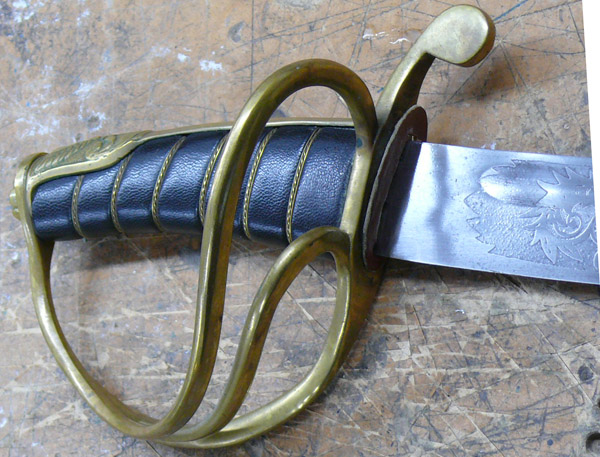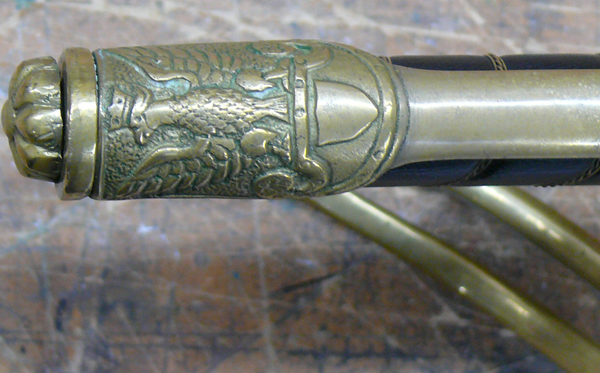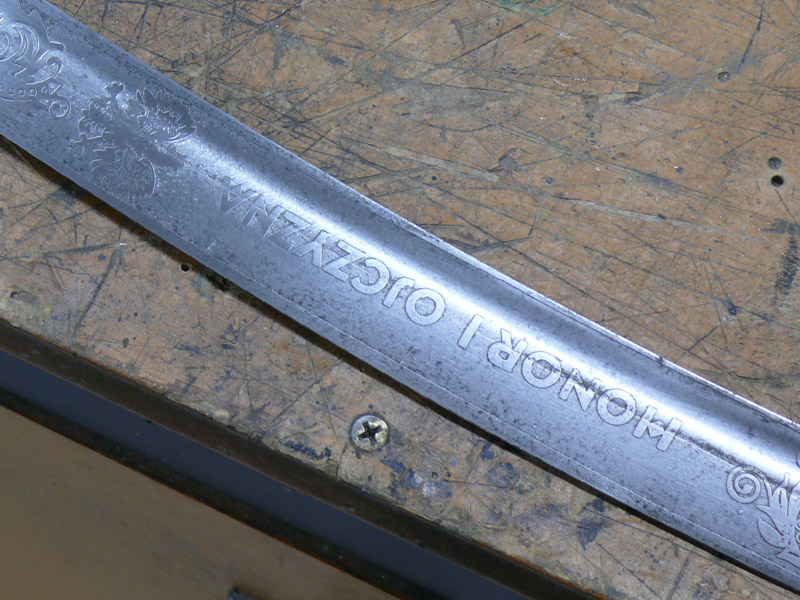| Author |
Message |
|
Peter Lyon
Industry Professional
|
 Posted: Thu 10 May, 2012 1:38 am Post subject: Polish sabre identity Posted: Thu 10 May, 2012 1:38 am Post subject: Polish sabre identity |
 |
|
One of my coworkers showed me an interesting sabre today, it is one of those weapons that really tells a story, and I would like some help identifying it. Unfortunately I won't be able to post any photos until after the weekend, but hopefully the description will help somewhat.
It was presented to his grandfather after WW2 in recognition for his efforts in the Polish underground. He will try to get more details from his mother for me to post. My first thought on seeing it was that it would be a Hussar sabre, I don't know whether his grandfather was in the Polish cavalry or not.
It is a sabre, nicely curved blade, parallel along its length, but not heavy in the hand. Good hard steel (the initial cleanup of rust didn't touch the etching), probably well heat treated, with a slight kink about 2/3 along the blade where the fuller ends and the cross section changes (I've seen this happen on many blades where the cross section changes, so it doesn't mean much in itself). An etched panel on one side, with the words "Honor I Ojczyzna" ("Honour and Fatherland, or Honour and Country) and a crowned eagle facing its right. On the other side of the blade is an oval stamp with the words as near as I can tell "W.KRAWCZYK" (Krawczyk is a common surname in Poland) and "ul.TKACKA203" (this seems to be an address).
The hilt is brass.The knuckle guard has three arms (very similar to a Confederate sabre I have seen) with two oval stamps on the front face: ARMA (armoury) and WK (don't know what this means - the location of the armoury that made the hilt? Possibly the hilt and blade are from different sources). The grip has a brass backing plate which has another eagle (crowned, facing its right) in raised detail on it. The grip is held to the blade with a rosette screw on the pommel.
As I said, I will post photos and more details when I can, but any help will be appreciated from this description.
Still hammering away
|
|
  |
 |
Bartek Strojek

|
|
  |
 |
|
Peter Lyon
Industry Professional
|
 Posted: Thu 10 May, 2012 11:14 am Post subject: Posted: Thu 10 May, 2012 11:14 am Post subject: |
 |
|
Thanks for that. It is not quite like either sword - the blade is like the first (one fuller each side), but the knuckle guard does not have the hard angle at the front plate that seems to be typical of these sabres, it is curved all the way.
Still hammering away
|
|
  |
 |
Bartek Strojek

|
|
  |
 |
|
Peter Lyon
Industry Professional
|
 Posted: Sat 12 May, 2012 10:06 pm Post subject: Posted: Sat 12 May, 2012 10:06 pm Post subject: |
 |
|
Here are the photos:
 Attachment: 144.86 KB Attachment: 144.86 KB

 Attachment: 235.31 KB Attachment: 235.31 KB

 Attachment: 202.88 KB Attachment: 202.88 KB

 Attachment: 168.81 KB Attachment: 168.81 KB

 Attachment: 142.98 KB Attachment: 142.98 KB
[ Download ]
 Attachment: 191.48 KB Attachment: 191.48 KB
[ Download ]
 Attachment: 249.73 KB Attachment: 249.73 KB
[ Download ]
Still hammering away
|
|
  |
 |
|
Peter Lyon
Industry Professional
|
 Posted: Sat 12 May, 2012 10:08 pm Post subject: Posted: Sat 12 May, 2012 10:08 pm Post subject: |
 |
|
Basic dimensions are blade 800mm long (about 32") and overall length 920mm (about 36.5").
Still hammering away
|
|
  |
 |
|
Peter Lyon
Industry Professional
|
 Posted: Thu 17 May, 2012 2:44 am Post subject: Posted: Thu 17 May, 2012 2:44 am Post subject: |
 |
|
I found out a bit more about his grandfather, if that helps.
He resisted the Germans during WW2, then resisted the Russians after that. He was always on the run, narrowly avoiding capture a few times, keeping secret gun caches and so on. The timeline we've pieced together suggests that he was presented with the sword after Poland got its independance again (1989ish?), and the sword was handed on to the guys daughter, who kept in the corner in her house in New Zealand.
Is there anyone out there who recognises this type of sword, and whether it has any special significance (for example, was it one of a few handed out, or one of hundreds/thousands). Any information will be good, I get fascinated when a sword has a story like this attached to it and want to find out a bit more.
Still hammering away
|
|
  |
 |
Lukasz Klimek

|
 Posted: Sun 20 May, 2012 6:29 am Post subject: Polish sabre identity Posted: Sun 20 May, 2012 6:29 am Post subject: Polish sabre identity |
 |
|
Hello,
It's probably a replica. Looks like polish cavalry saber wz. 1917 (wz. stands for type or mk.). After the fall of communism in 1989 such replicas were given as awards to those who have rendered great service to the Polish nation. Lech Walesa was given very similar saber to that on Your pictures. So it's probably rare.
|
|
  |
 |
|
|

